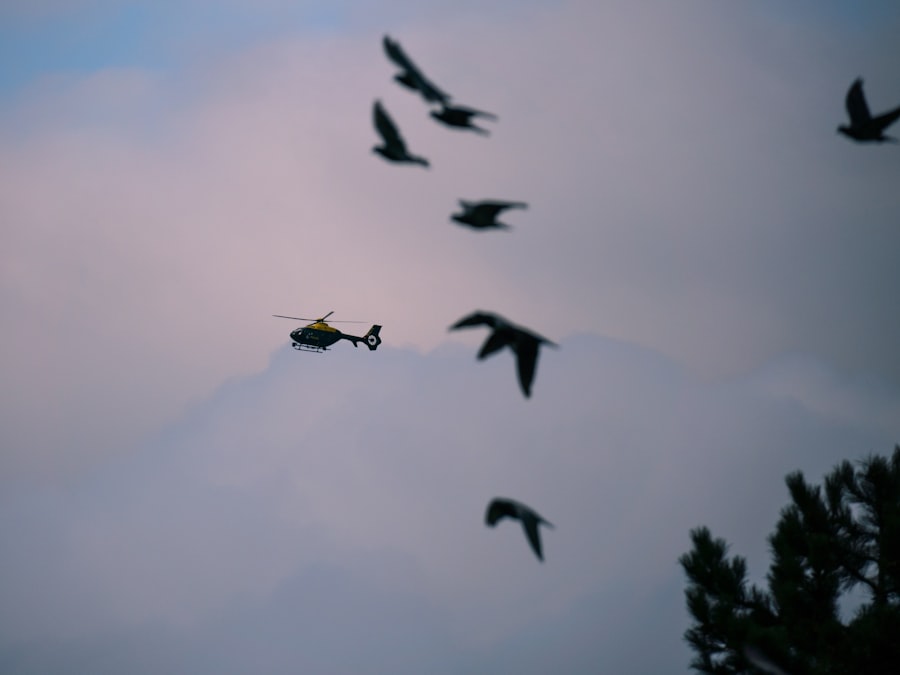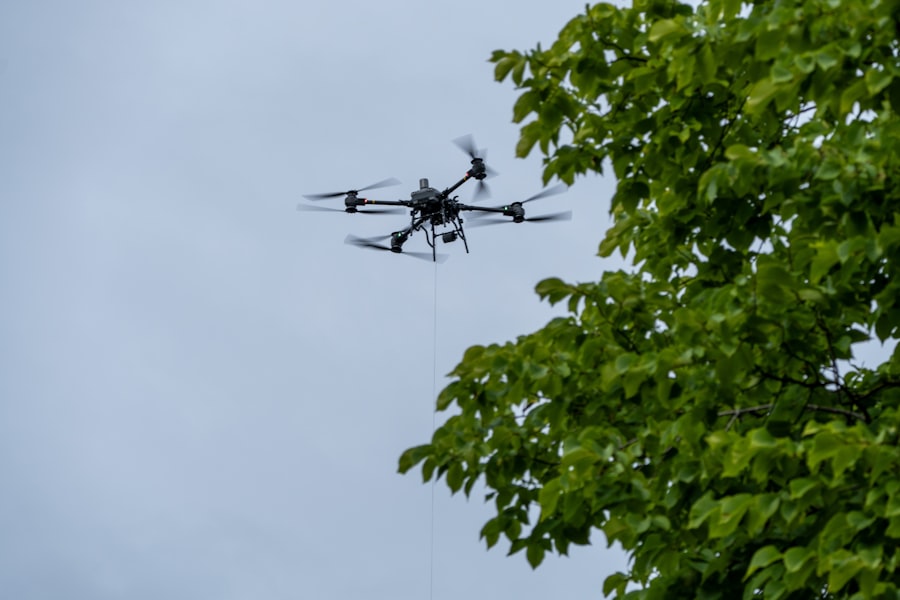In recent years, the emergence of drone swarms has transformed the landscape of aerial technology, presenting both opportunities and challenges.
These swarms can perform a variety of tasks, from surveillance and reconnaissance to delivering goods and conducting search-and-rescue missions.
The ability of these drones to communicate and coordinate with one another allows them to cover vast areas efficiently, making them an attractive option for various industries, including agriculture, logistics, and military operations. However, the very characteristics that make drone swarms advantageous also pose significant risks. The potential for misuse by malicious actors raises concerns about security and safety.
For instance, a coordinated swarm could be employed for nefarious purposes, such as conducting surveillance on sensitive locations or even launching attacks. Understanding the dynamics of drone swarms is crucial for developing effective countermeasures and ensuring that their deployment remains beneficial rather than harmful. As technology continues to evolve, so too must the strategies for managing and mitigating the risks associated with these advanced aerial systems.
Key Takeaways
- Drone swarms are a group of drones that work together in a coordinated manner, often used for surveillance or attack purposes.
- Potential threats from drone swarms include unauthorized surveillance, smuggling of contraband, and potential terrorist attacks.
- Anti-drone technology such as signal jamming, net guns, and drone detection systems can be utilized to counter drone threats.
- Counter-drone tactics involve disrupting communication between drones and their operators, as well as physically disabling or capturing the drones.
- Establishing no-fly zones and implementing drone detection systems are crucial steps in preventing unauthorized drone activity.
Identifying Potential Threats
The identification of potential threats posed by drone swarms is a critical step in safeguarding public safety and national security. Various factors contribute to the threat landscape, including the capabilities of the drones themselves, the intentions of their operators, and the environments in which they are deployed. For instance, drones equipped with high-resolution cameras can gather intelligence on sensitive infrastructure, while those armed with explosives could be used in targeted attacks.
The versatility of drone technology means that threats can manifest in numerous forms, making it essential for security agencies to remain vigilant. Moreover, the proliferation of drone technology has made it increasingly accessible to individuals and groups with varying motives. Hobbyists may use drones for recreational purposes, while others may exploit them for criminal activities or terrorism.
Identifying these potential threats requires a comprehensive understanding of the drone ecosystem, including the types of drones available on the market, their capabilities, and the profiles of their operators. By analyzing patterns of drone usage and monitoring emerging technologies, security agencies can better anticipate and respond to potential threats before they materialize.
Utilizing Anti-Drone Technology

As the threat posed by drone swarms becomes more pronounced, the development and deployment of anti-drone technology have gained significant traction. Various solutions have emerged to counteract the risks associated with unauthorized or malicious drone activity. These technologies range from electronic countermeasures that disrupt communication signals to physical interception methods that neutralize drones in flight.
Each approach has its advantages and limitations, necessitating a tailored strategy based on specific threat scenarios. One prominent method involves jamming the radio frequencies used by drones to communicate with their operators. By disrupting these signals, security personnel can effectively render the drones inoperable.
However, this approach must be used judiciously, as it can also interfere with legitimate drone operations in the vicinity. Another innovative solution involves deploying drones equipped with nets or other capture mechanisms to physically intercept rogue UAVs. This method allows for a more targeted response while minimizing collateral damage.
As anti-drone technology continues to evolve, ongoing research and development will be essential to enhance its effectiveness and adaptability in an ever-changing threat landscape.
Developing Counter-Drone Tactics
| Tactic | Effectiveness | Cost |
|---|---|---|
| Signal Jamming | High | Medium |
| Physical Netting | Low | High |
| Drone Detection Systems | Medium | High |
| Directed Energy Weapons | High | High |
The development of counter-drone tactics is essential for organizations seeking to protect themselves from potential threats posed by drone swarms. These tactics must be multifaceted, incorporating both proactive measures to deter unauthorized drone activity and reactive strategies to respond effectively when incidents occur. A comprehensive approach may involve a combination of technological solutions, policy frameworks, and operational protocols tailored to specific environments.
One effective tactic is the establishment of a layered defense system that integrates various anti-drone technologies. By employing multiple detection methods—such as radar systems, radio frequency scanners, and visual monitoring—security personnel can create a robust surveillance network capable of identifying potential threats early on. Additionally, training personnel to recognize suspicious drone behavior can enhance situational awareness and facilitate timely responses.
Furthermore, organizations should consider developing partnerships with technology providers to stay abreast of emerging counter-drone solutions and best practices.
Establishing No-Fly Zones
Establishing no-fly zones is a critical component of any comprehensive strategy aimed at mitigating the risks associated with drone swarms. These designated areas prohibit unauthorized drone flights and serve as a deterrent against potential threats. No-fly zones can be established around sensitive locations such as government buildings, military installations, airports, and large public events where large crowds gather.
By clearly delineating these zones and communicating them effectively to the public, authorities can reduce the likelihood of unauthorized drone activity in high-risk areas. The implementation of no-fly zones requires collaboration between various stakeholders, including government agencies, law enforcement, and aviation authorities. Effective enforcement mechanisms must be put in place to monitor compliance and address violations promptly.
This may involve deploying surveillance systems capable of detecting unauthorized drones within no-fly zones and implementing penalties for offenders. Additionally, public awareness campaigns can help educate drone operators about the importance of respecting these restrictions and understanding the potential consequences of violating them.
Implementing Drone Detection Systems

The implementation of drone detection systems is vital for organizations seeking to enhance their security posture against potential threats posed by drone swarms. These systems utilize advanced technologies to identify and track drones operating within a designated airspace. By employing a combination of radar, radio frequency analysis, and visual detection methods, security personnel can gain real-time situational awareness regarding drone activity in their vicinity.
One key advantage of drone detection systems is their ability to provide early warning signals that allow for timely responses to potential threats. For instance, if a drone is detected approaching a sensitive area, security personnel can take proactive measures to mitigate risks before any harm occurs. Additionally, integrating detection systems with existing security infrastructure can create a comprehensive surveillance network that enhances overall situational awareness.
As technology continues to advance, ongoing investment in drone detection capabilities will be essential for staying ahead of evolving threats.
Training Security Personnel
Training security personnel is a fundamental aspect of any effective counter-drone strategy. As drone technology evolves rapidly, it is crucial for security teams to stay informed about the latest developments in both drone capabilities and countermeasures. Comprehensive training programs should encompass various aspects of drone operations, including identification techniques, threat assessment protocols, and response strategies tailored to different scenarios.
Moreover, hands-on training exercises can help personnel develop practical skills in operating anti-drone technologies and responding effectively to incidents involving unauthorized drones. Simulated scenarios can provide valuable experience in assessing potential threats and executing appropriate countermeasures under pressure. By fostering a culture of continuous learning and adaptation within security teams, organizations can enhance their resilience against emerging threats posed by drone swarms.
Creating Emergency Response Plans
Creating emergency response plans is essential for organizations aiming to address potential incidents involving drone swarms effectively. These plans should outline clear protocols for identifying threats, assessing risks, and executing appropriate responses in real-time situations. A well-structured emergency response plan not only enhances organizational preparedness but also instills confidence among stakeholders regarding safety measures in place.
Key components of an effective emergency response plan include communication protocols that ensure timely information sharing among security personnel, law enforcement agencies, and relevant stakeholders. Additionally, establishing designated roles and responsibilities within response teams can streamline decision-making processes during incidents involving drones. Regular drills and exercises should be conducted to test the effectiveness of these plans and identify areas for improvement.
By prioritizing preparedness through comprehensive emergency response planning, organizations can mitigate risks associated with drone swarms more effectively.
Collaborating with Law Enforcement Agencies
Collaboration with law enforcement agencies is crucial for organizations seeking to enhance their counter-drone efforts. Law enforcement plays a vital role in enforcing regulations related to drone operations and addressing incidents involving unauthorized or malicious use of drones. By fostering strong partnerships between private organizations and law enforcement agencies, stakeholders can create a unified approach to addressing potential threats posed by drone swarms.
Joint training exercises can facilitate knowledge sharing between security personnel and law enforcement officers regarding best practices for identifying and responding to drone-related incidents. Additionally, establishing clear communication channels between organizations and law enforcement can enhance situational awareness during emergencies involving drones. By working together collaboratively, stakeholders can develop comprehensive strategies that leverage each other’s expertise in mitigating risks associated with drone swarms effectively.
Engaging in Diplomatic Efforts
Engaging in diplomatic efforts is an often-overlooked aspect of addressing the challenges posed by drone swarms on a global scale. As countries grapple with the implications of emerging drone technologies, international cooperation becomes essential for establishing norms and regulations governing their use. Diplomatic initiatives can facilitate dialogue among nations regarding best practices for managing drone operations while addressing concerns related to security and safety.
International forums provide opportunities for stakeholders from various countries to share insights into their experiences with drone technology and its implications for national security. Collaborative efforts may lead to the development of treaties or agreements aimed at regulating cross-border drone operations and preventing misuse by malicious actors. By fostering a spirit of cooperation among nations regarding drone technology governance, stakeholders can work towards creating a safer global environment where the benefits of drones are harnessed responsibly.
Investing in Research and Development
Investing in research and development (R&D) is paramount for advancing counter-drone technologies and strategies that address emerging threats effectively. As drone technology continues to evolve rapidly, ongoing R&D efforts are necessary to stay ahead of potential risks associated with drone swarms. This investment not only enhances existing capabilities but also fosters innovation that can lead to groundbreaking solutions for mitigating threats posed by unauthorized or malicious drone activity.
Collaboration between government agencies, private sector companies, and academic institutions can drive advancements in counter-drone technologies through shared expertise and resources. Research initiatives may focus on developing more sophisticated detection systems capable of identifying drones at greater distances or enhancing anti-drone technologies that minimize collateral damage during interception attempts. By prioritizing R&D investments aimed at addressing the challenges posed by drone swarms comprehensively, stakeholders can ensure that they remain prepared for an evolving threat landscape while maximizing the benefits associated with this transformative technology.
In the rapidly evolving landscape of modern warfare, understanding how to counteract emerging threats like drone swarms is crucial. An insightful article that complements the strategies discussed in “How to Defeat a Drone Swarm” can be found on the website In The War Room. This article delves into the technological advancements and tactical approaches necessary to effectively neutralize such threats. For a deeper exploration of these concepts, you can read more about it on their homepage, where they provide a comprehensive analysis of current military strategies and innovations.
FAQs
What is a drone swarm?
A drone swarm is a group of drones that work together in a coordinated manner to achieve a common goal. These drones can be used for various purposes such as surveillance, delivery, or even military attacks.
How can a drone swarm be defeated?
There are several methods to defeat a drone swarm, including using electronic jamming to disrupt their communication and control signals, deploying anti-drone weapons such as net guns or laser systems, and using physical barriers to block their movement.
What are some challenges in defeating a drone swarm?
One of the main challenges in defeating a drone swarm is their ability to operate autonomously and adapt to changing conditions. Additionally, drone swarms can be difficult to detect and track, making it challenging to effectively counter them.
Are there any legal considerations when defeating a drone swarm?
Yes, there are legal considerations when defeating a drone swarm, especially if the drones are being used for civilian or commercial purposes. It is important to ensure that any countermeasures used comply with local laws and regulations regarding drone operations.
What are some future developments in countering drone swarms?
Future developments in countering drone swarms may include the use of advanced artificial intelligence and machine learning algorithms to improve detection and tracking capabilities, as well as the development of more sophisticated anti-drone technologies. Additionally, international efforts to establish regulations for drone operations and countermeasures are also being explored.




